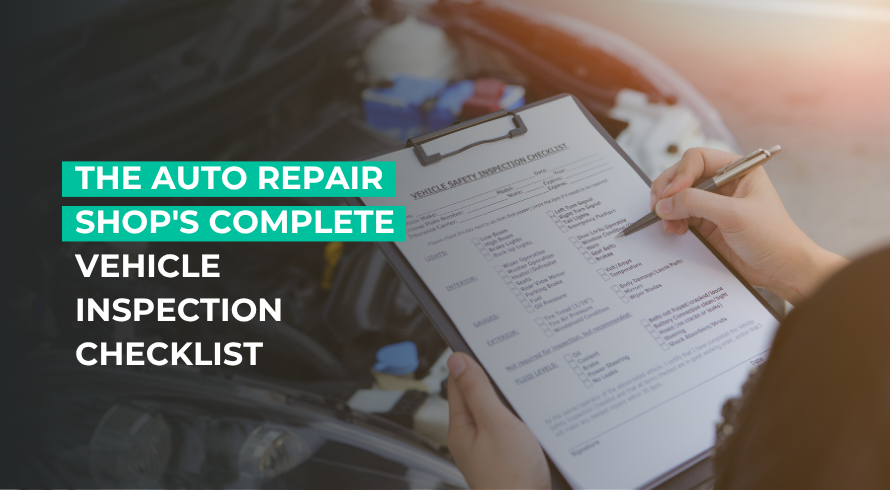A clear inspection checklist is essential. It helps you spot issues early, keep cars safe, and earn your customers’ trust. Whether you’re checking a used car before a sale or doing regular maintenance, a consistent process is key.
Why is the checklist important?
- Catch problems before they get expensive.
- Keep your inspection process fast and consistent.
- Build trust with clear records and honest feedback.
25 things to inspect during a vehicle inspection
Use this automotive inspection checklist as a guide during every inspection. It covers everything from paperwork to test drives. It’s designed to save time, avoid missed details, and boost your shop’s reputation for quality service. Here are 25 key areas every shop should inspect during a vehicle inspection:
-
Vehicle Identification (VIN, License Plate)
Log VIN and plate to confirm identity, match past records, and maintain an accurate vehicle inspection log.
-
Odometer Reading
Record mileage to track wear, plan maintenance, and verify the integrity of service records.
-
Engine Oil Level & Condition
Use a dipstick to check for the correct level and clear amber appearance. Dark or gritty oil may signal overdue servicing.
-
Coolant Level & Leaks
Inspect the reservoir when cold, verify fill lines, and look for residue or smell of coolant around hoses or radiator.
Brake Fluid Level
The brake-fluid reservoir should sit between minimum/maximum marks. Cloudy or low levels can indicate leaks or pad wear.
Transmission Fluid
Examine the dipstick fluid for automatic vehicles. It should be reddish and clear. Brown or burnt scent signals a possible need for fluid change.
Battery Condition & Cables
Check the battery for corrosion at terminals, and ensure proper voltage. Technicians can use a battery tester to verify health over time.
Air Filter & Cabin Filter
It’s time to replace the air filter when you hold the filter up to light and dirt blocks most light. This is done to ensure airflow and cabin air quality.
Drive Belts & Hoses
Worn belts or hoses can cause engine damage.Check for signs of wear, like cracks or softness.
Check Engine Light or Dash Warnings
Scan the dash for active warnings. Even blinking lights can point to serious underhood issues.
Brake Pads & Rotors
Examine pad thickness and rotor surface. Thin pads or scored rotors may compromise safety and require replacement.
Suspension Components (Shocks, Struts)
Press down on vehicle corners. If it bounces more than twice, inspect for worn shocks or struts. This is important to ensure it doesn’t affect ride and handling.
-
Steering System (Tie Rods, Ball Joints)
Check steering wheel play and inspect linkages. Excessive slack can make handling dangerous.
-
Tire Tread Depth & Wear Patterns
Use a gauge for tread depth and look for uneven wear, which can indicate suspension or alignment issues.
Tire Pressure & Spare Tire
Measure all tires, including the spare. Inspect sidewalls for cracking or bulges to avoid blowout.
Wipers & Washer Fluid
Test wipers for streaking or cracks. Top off washer fluid to support clear visibility, especially in adverse conditions.
Headlights, Taillights, Brake Lights
Check all exterior lighting for lens clarity. Proper functioning of these lights ensure safety and avoid traffic fines.
Turn Signals & Hazards
Ensure turn signals and hazards flash at the correct rate. Weak or slow signals can confuse other drivers.
HVAC System Function
Test heating, cooling, vent airflow, and defroster for effectiveness and cabin comfort.
Seat Belts & Safety Restraints
Fully pull belts to test locking. Inspect retractors and webbing for fraying to ensure occupant safety.
Interior Lights & Gauges
Verify interior lights and instrument cluster operation. Malfunctioning gauges can mislead drivability checks.
Body & Paint Condition
Inspect for dents, rust, or mismatched paint. This can indicate past damage or corrosion risks.
Windshield, Mirrors & Glass
Adjust mirrors and check that glass surfaces don’t impair vision due to chips or cracks.
Undercarriage & Exhaust System
Examine for leaks, rust, or damage. A secure exhaust prevents harmful fumes or performance issues.
-
Test Drive: Breaking, Acceleration, Noise
Drive the vehicle to assess starting behavior, smooth gear shifts, brake feel, steering response, and any unusual noises.
This list ensures nothing slips through the cracks, giving your team a clear picture of the vehicle’s condition.
How to use a vehicle checklist in your shop
- Download the full vehicle inspection checklist.
- Tailor it to fit your shop’s workflow.
- Add comments for tech notes and pictures.
- Use color codes or tools to flag vehicle issues.
- Review with the customer, digitally or in person.
Schedule a free demo today!

Boost your shop sales

Simplify shop management

Empower your technicians
Who conducts the vehicle inspection at the repair shop?
Vehicle inspections are typically handled by trained automotive technicians. They use a mix of visual checks, manual tools (like tread depth gauges), and other digital tools. Many shops now rely on Digital Vehicle Inspection software (DVI) to ease and automate the process.
DVI tools allow technicians to capture photos, record notes, and mark parts using a color-coded system. For example, green means “OK,” yellow means “monitor,” and red means “needs attention.” This makes it easier for customers to understand and differentiate between urgent or trivial issues.
Should vehicle inspections be done daily, weekly, or monthly?
The right inspection frequency depends on vehicle usage:
- Daily Inspections: Ideal for fleet vehicles, delivery vans, or any vehicle used intensively every day. Basic checks like tires, brakes, and fluids should be included.
- Weekly Inspections: Suitable for vehicles that aren’t driven daily but are still active. A mid-level inspection works best.
- Monthly Inspections: Most personal-use vehicles or light-duty commercial vehicles can follow this schedule.
For your shop, offering inspection packages based on usage type helps customers stay proactive and can bring in recurring business.
Advantages of regular vehicle inspections
- Fewer breakdowns: Catching issues early reduces surprise breakdowns and customer complaints.
- Stronger customer relationships: Transparent reporting builds trust, especially when paired with before/after visuals.
- Increased repair approvals: Clear visual proof and detailed notes from DVI tools help customers say “yes” to repairs.
- Higher efficiency: Technicians work faster and more accurately with a standardized checklist in hand.
- Record-keeping: Digital records of inspections help with warranty issues, insurance claims, or future diagnostics.
Wrapping up
A proper vehicle inspection checklist is a must-have for every repair shop. It improves efficiency, safety, and customer confidence. With AutoLeap’s digital vehicle inspection feature, you can manage the whole process. Take photos and notes, save checklists from your tablet or phone.
Frequently asked questions
What is the use of a vehicle inspection checklist?
The inspection checklist will ensure you cover all your bases and complete a thorough review of your customer’s vehicle.
What is the vehicle inspection procedure?
You run through a detailed checklist with the vehicle in question to ensure all is in good condition. It is essentially measuring, testing and examining the many components of vehicles that enter your shop.
What does inspection checklist mean?
It is a document that records all inspection steps for a customer’s vehicle in your shop.









